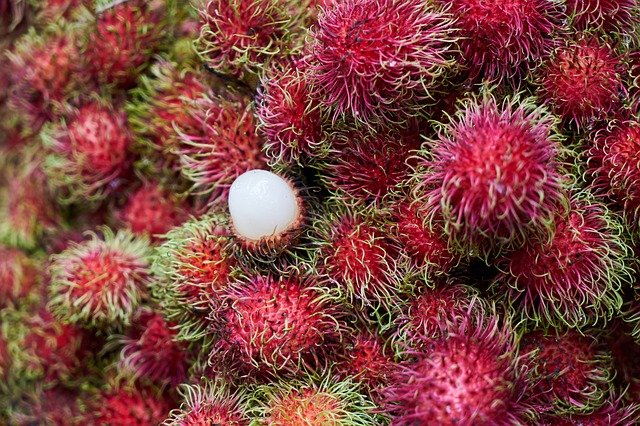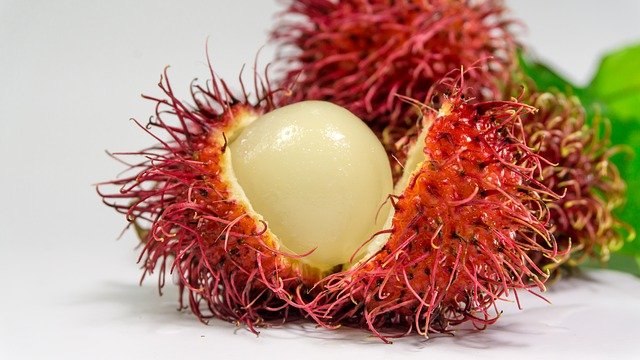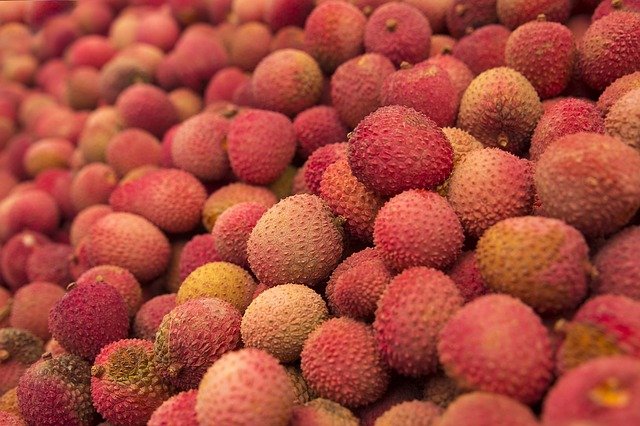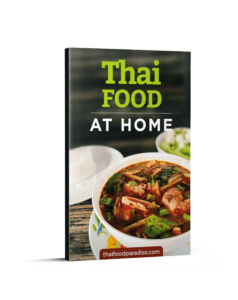Rambutan vs Lychee: What’s The Difference?

One of the great things about travelling to Thailand is simply wandering around the local markets and being greeted by a dazzling array of fruits and vegetables you’ve never seen. It’s a veritable assault on the senses. This article takes a look at and compares rambutan vs lychee; two popular fruits you’ll see a lot of in Thailand.
What is a Rambutan?
Rambutan is a fruit that grows on a tropical tree of the same name. The Thais use the word “ngaw” (เงาะ) for rambutan. The fruit, when peeled, looks quite similar to a lychee, which is one reason to compare them.

Rambutan fruit, when not yet peeled, looks like some rare underwater creature you might encounter while scuba diving along the coral reefs of southern Thailand rather than being an edible fruit. The creepy-looking skin is red and hairy due to being covered with fleshy flexible ‘spines’. The fruit is round or oval-shaped.
When you peel the scary looking skin, you’re left with a translucent white fruit that is slightly juicy and very much resembles peeled lychee. The taste is mostly sweet with a mild hint of acidity. The best time to find rambutan in Thailand is in the period between June and September each year.
If you don’t want to go to Thailand to try this fruit, you can buy 2-lbs worth on Amazon here. Be careful and check the reviews though; some people report the fruit isn’t as fresh as it should be. You can try your local Asian grocery store as well, but experience tells me it can be difficult to get rambutan.
Be careful not to eat either the skin or the seed of the rambutan. The only part recommended for eating eat is the fleshy fruit.
What is a Lychee?

Lychee is a popular fruit found in Thailand that grows on a tropical tree of the same name. The tree is native to China, however, it’s cultivated widely across Southeast Asia.
Lychee fruit is small and it has a pink-red hue with a rough leathery skin that you cannot eat. You typically buy this fruit by the kilo at markets. It’s also popular in Thailand to find lychee juice ready to consume at street-side stalls: its sweetness can be refreshing on a hot day.
Peeled lychee fruit is fleshy with a translucent white colour and a pleasant floral aroma. The taste is quite a mild sweetness, but it’s a very juicy, succulent fruit that tastes really pleasant in warm weather.
There’s a lovely pleasant middle-aged woman in the Saturday Walking Street Market in Chiang Mai who sells a really pleasant wine made from lychee. The floral notes work wonderfully, and the flavour is very reminiscent of a fruity white wine.
The fruit can be dangerous to children, particularly when unripe and eaten by kids who are malnourished. The advice is for kids to limit consumption and to ensure they eat the fruit after a meal. And the advice for anyone reading is to not eat either the skin or the seed inside the fruit.
In the Thai language, the word for lychee is “lin-chee” which is thankfully very similar to English. You’ll find it at its peak in the hot season in Thailand, which lasts from April to June.
Rambutan vs Lychee: Differences and Similarities
Rambutan and lychee are actually a part of the same family of plants; Sapindaceae. (I struggle to pronounce that word). The peeled fruits of these two plants look pretty similar. The difference in appearance between unpeeled rambutan and lychee is more striking, as you can see from the pictures on this page.
Size-wise, rambutans are typically larger. Expect most rambutan fruits to be roughly the size of a golf ball. Lychee fruit is typically about the size of a grape.
It’s definitely easier to peel the bumpy skin from a lychee than the hairy skin of the rambutan. To open a lychee, you simply break open the skin with your thumb. To open a rambutan, you’ll normally need to pierce the skin with a sharp knife and open it from there. It’s sometimes possible to twist open the skin with your hands if you have a particularly ripe rambutan.
In terms of taste, rambutans have a sharper more acidic note to their sweetness while lychees have a milder, more floral note to them. Lychee fruit is usually juicier and more succulent than rambutan.
Nutritionally, the fruits are quite similar. 100 grams (~3.5-oz) of rambutan has around 70 calories, 15 grams of sugar, and is a good source of vitamin C. The same-sized serving of lychee fruit has nearly the same amount of calories and sugar. Lychee is also a good source of vitamin C, but it has the additional benefit of being a good source of copper too.
Closing Thoughts
Hopefully, this page proves a useful resource if you were in need of a comparison between rambutan vs lychee. If you’re interested in other exotic Thai fruits, check out my article describing mangosteens and what they are. As a brief primer for that article, one author described the fruit as “thrillingly, intoxicatingly, luscious.”
Have you tried rambutans or lychee? Which one of these great exotic fruits do you prefer? Let me know in the comments below. See you next time.
🙂
I lived in Thailand for a few years during my 20s during which time I fell in love with Thai food. Along with my Thai partner, I cook and eat tasty Thai dishes 3 or 4 times per week. I’m here to bring you recipes, Thai food tips, and suggested cookware for making Thai food.
